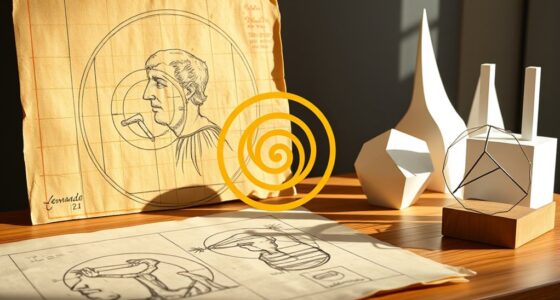Sacred geometry in ancient cultures uses symbols and shapes like circles, triangles, and squares to represent universal truths and spiritual concepts. These patterns often serve as a bridge between the physical and divine, embodying ideas like eternity, harmony, and cosmic order. Temples, art, and rituals incorporate these geometries to connect individuals with higher forces and reveal hidden truths. If you keep exploring, you’ll uncover even deeper meanings behind these timeless symbols.
Key Takeaways
- Sacred geometry uses specific mathematical patterns like circles, triangles, and squares to symbolize universal spiritual principles.
- Shapes such as circles and triangles represent eternity, wholeness, balance, and harmony in ancient cultures.
- Architectural and ritual patterns encode spiritual messages and reflect the universe’s divine structure.
- Cultures like Egyptian and Indian incorporated sacred geometry into temples, pyramids, and mandalas for spiritual connection.
- Sacred geometry serves as a universal language that unites material and spiritual realms across civilizations.

Sacred geometry plays a vital role in many ancient cultures, serving as a bridge between the physical world and spiritual beliefs. When you explore these cultures, you’ll notice that they often used specific mathematical patterns to symbolize universal truths or divine principles. These mathematical patterns, such as the circle, square, and triangle, aren’t just random shapes; they embody deeper meanings that connect the material and spiritual realms. For instance, circles represent eternity, wholeness, and the infinite, while triangles often symbolize balance and harmony. These shapes form the foundation of sacred symbols found across different civilizations, from Egyptian pyramids to Indian mandalas.
Sacred geometry uses shapes like circles, squares, and triangles to symbolize divine principles across cultures.
The cultural significance of these mathematical patterns runs deep. In many ancient societies, these shapes were believed to hold the key to understanding the universe’s structure. They served as tools for meditation, ritual, and architecture, helping people align themselves with cosmic forces. You might notice that many sacred sites are designed with precise geometric proportions, such as the Golden Ratio, which embodies aesthetic harmony and divine proportion. These patterns were considered a language of the divine, allowing individuals to tap into higher wisdom through visual representation. They reinforced social cohesion by creating shared symbols that expressed collective spiritual ideals.
In Egyptian culture, for example, the use of geometric patterns in tombs and temples reflected their view of the universe and the afterlife. These patterns were thought to guarantee a successful journey into the spiritual realm. Similarly, in Indian traditions, mandalas use intricate geometric designs to represent the cosmos and aid in spiritual practices like meditation. The mathematical precision in these symbols underscores their importance in connecting practitioners with the divine order. Across cultures, you’ll find that geometric patterns were more than decorative; they were sacred tools that encoded complex spiritual messages and cultural values.
Understanding the cultural significance of these mathematical patterns helps you appreciate how ancient peoples perceived their world. They saw geometry as a way to unearth hidden truths, bridge the physical and spiritual planes, and express their worldview visually. Whether through architecture, art, or ritual objects, these patterns serve as a universal language that embodies spiritual ideals. By recognizing their importance, you gain insight into how ancient civilizations sought harmony and mystical connection through the timeless language of sacred geometry. This enduring legacy continues to inspire modern interpretations of spirituality, art, and architecture, proving that these mathematical patterns remain powerful symbols of universal truth.
Frequently Asked Questions
How Did Ancient Cultures Discover Sacred Geometric Principles?
You discover that ancient cultures uncovered sacred geometric principles through keen observation of nature and mathematical insights. They closely examined patterns in the cosmos, plants, and animals, which led to recognizing universal proportions. Cultural exchanges also played a vital role, sharing mathematical ideas across civilizations. By combining their observations and interactions, they developed symbols and structures that embodied these sacred geometric truths, shaping their spiritual and architectural practices for generations.
Are Sacred Symbols Universal Across All Ancient Civilizations?
Imagine you’re exploring ancient ruins and notice similar symbols, like the circle or spiral. Sacred symbols often appear across cultures because they represent universal geometric patterns, reflecting shared human understanding of the universe. Cross-cultural symbolism suggests that these patterns, like the golden ratio, carry deep spiritual meanings. While not all symbols are identical, many embody fundamental ideas about harmony, balance, and creation, making sacred geometry truly universal across ancient civilizations.
What Role Did Sacred Geometry Play in Religious Rituals?
You notice that sacred geometry plays a essential role in religious rituals by guiding meditative practices and ritual construction. Using precise geometric patterns, you can focus your mind and deepen spiritual connection during ceremonies. These symbols help structure sacred spaces, making rituals more meaningful and powerful. By incorporating sacred geometry, you enhance your ritual experience, creating a harmonious environment that aligns with divine proportions and universal truths.
Can Sacred Geometry Be Linked to Modern Scientific Concepts?
Yes, sacred geometry can be linked to modern scientific concepts through mathematical correlations, which reveal underlying patterns in nature. You’ll find that principles like the golden ratio and fractals have scientific validation, showing how these ancient symbols mirror natural phenomena. By studying these connections, you can see how sacred geometry bridges spirituality and science, offering insights into the universe’s fundamental structure.
How Has Sacred Geometry Influenced Contemporary Art and Architecture?
You see how sacred geometry influences contemporary art and architecture through geometric patterns that create harmony and balance. Modern design often incorporates these patterns to evoke a sense of spirituality or universal connection. Architects and artists use sacred geometry to craft visually striking structures and artworks, blending ancient symbolism with modern aesthetics. This seamless integration enriches design, making it both meaningful and mesmerizing, resonating deeply with viewers and users alike.
Conclusion
As you explore the symbols and meanings behind sacred geometry, you realize it’s a universal language connecting ancient cultures across time. These symbols reveal wisdom and spiritual truths that still resonate today. Remember, “A picture is worth a thousand words.” By understanding these patterns, you deepen your appreciation for humanity’s shared quest for harmony, balance, and divine understanding—reminding you that, in the end, we’re all part of a greater, interconnected design.









